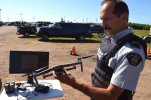So…I must have missed a meeting or something, because someone suddenly put me in charge. As a result, I am looking for a lot of information and answers.
Who we are: a county Search & Rescue operation under SO auspices in Northern CA. We have apparently had this drone program for a couple of years, but have never used it on a search, nor have we really trained with it. It is clear to me that the drone will frequently NOT be the best tool in the box, but there will certainly be times when it can either help find someone, or will be helpful in keeping a team safe.
What we have: M2ED with (supposedly) up-to-date apps, software, and databases running on a large CrystalSky. Bird has all of four batteries. No goggles currently
What I am hoping to learn—
If this is something better posted elsewhere please let me know.
Thanks
Who we are: a county Search & Rescue operation under SO auspices in Northern CA. We have apparently had this drone program for a couple of years, but have never used it on a search, nor have we really trained with it. It is clear to me that the drone will frequently NOT be the best tool in the box, but there will certainly be times when it can either help find someone, or will be helpful in keeping a team safe.
What we have: M2ED with (supposedly) up-to-date apps, software, and databases running on a large CrystalSky. Bird has all of four batteries. No goggles currently
What I am hoping to learn—
- Where is a good source of intel on how to set up a SAR drone program? Even though we have on set up conceptually, I want to approach this from the ground up, starting with the basics
- I have read the various manuals on the bird, on DJI Pilot and other DJI stuff. BUT….I am still desperately looking for descent, in-depth tutorials on how to read thermography for SAR on that specific bird. I am having problems getting my settings dialed In, including trying to find the “IsoTherm” setting that numerous people have mentioned in 3-minute videos: it simply isn’t showing up on my menus, even though I know the software is up-to-date.
- How many batteries is a good number to have for such an operation?
- how do you square the notion that you should not keep batteries charged all the time with the notion that for SAR you need to be ready to go at a moment’s notice?
- What are some good training exercises to do—either with or without a VO?
- day training
- night training
- Would one recommend getting a pair of goggles? (We used them (borrowed) in the one mission we had, an evidence search, and as best as I could tell they were moderately helpful.)
If this is something better posted elsewhere please let me know.
Thanks












